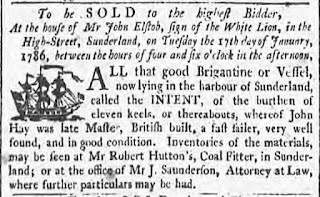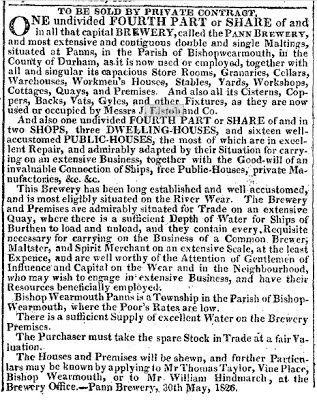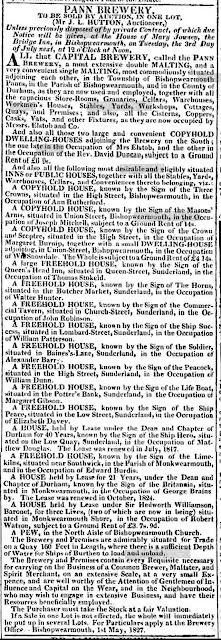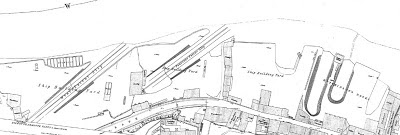When he marries Henrietta Brown in 1778 he is described in the newpaper report of their marriage as a Landwaiter in Customs in Sunderland. Henrietta was the daughter of a fellow Custom's Officer. After her death in 1780 he remarries (this is his fourth marriage that I am aware of) to Mary widow of John Swinburn, maiden name Thompson, and an indenture made up at the time of their marriage, referenced in her will, refers to him as "one his Majesty’s Officers of the Customs ".
 |
| 1786 Indenture or Articles of Clerkship for John Elstob the younger (from Ancestry) |
 |
| Newcastle Courant 7 Jan 1786 (from Find My Past - Newspapers) |
 |
| 1785-1790 Rain's Eye Plan (from the Sunderland Antiquarian Society) |
 |
| 1792 Mackintosh plan and bird's eye view (from Victoria County History) |
The 1792 Mackintosh survey of Sunderland, which form a pair showing the buildings on the banks of the Wear in plan and 'bird's eye' views confirms the placement and relative size of Elstob's brewery premises. It shows as a complex cluster of buildings on the plan and on the 'bird's eye view' appears much smaller, but maybe that is the elevation as seen from the river.
 |
| Newcastle Courant 6 June 1795 (from Find My Past - Newspapers) |
By 1795 John is renting a Malt-Kiln in Union Lane. He is making his own malt to supply his brewery.
A later trade directory, in 1829, does list the words "and maltsters" after the main entry for John Elstob and Co Brewery so he and his firm continued to prepare their own malt, by that time on their own premises.
 |
| Newcastle Courant 4 Oct 1800 (from British Newspaper Archive) |
The grand celebration related on the right to commemorate the installation of a huge porter-vat at Elstob and Co in 1800 gives an impression of how large a brewery it must have been and how good John was at publicising his firm. Imagine forty people around a table and still enough room for dancing around the edges - the vat must have been enormous!
In October 1811 a plea appears in the Tyne Mercury from the brewers of Sunderland, led by John Elstob. This newspaper has not appeared in digital form on the British Newspaper Archive yet so this is the transcript from the Victoria County History collection.
"To Coopers, Publicans, Makers of Ships and Others
COMMON BREWERS ASSOCIATION SUNDERLAND
We whose names are hereunder written, being Common Brewers in Sunderland near the Sea, in the County of Durham and the Neighbourhood, do agree to form ourselves into an Association for discovering and apprehending any person or persons who shall, or may at any time hereafter feloniously steal or receive (knowing to be stolen) any of our casks or brewing utensils; and as our joint and equal experience to prosecute such person or persons to conviction. And we will liberally reward any person or persons who shall give such information to Mr. Thomas Collin, Attorney, Bishopwearmouth, as shall be the means of bringing such a person or persons to justice. That Mr. John Elstob, Mr. John Taylor, Mr. James Bell and Mr. John Beecroft be and are hereby appointed a committee for paying rewards, directing prosecutions and therewith managing and conducting the business of the Association. And we hereby give this further notice that we will hereafter individually expect Publicans to return all casks committed to their charge, in good condition as when delivered to them and we will severally consider them answerable for and liable to make good all Damage any casks may receive by neglect or otherwise when in their custody, and will severally commence actions for the Recovery of the amount expended in repairing all such damage."
COMMON BREWERS ASSOCIATION SUNDERLAND
We whose names are hereunder written, being Common Brewers in Sunderland near the Sea, in the County of Durham and the Neighbourhood, do agree to form ourselves into an Association for discovering and apprehending any person or persons who shall, or may at any time hereafter feloniously steal or receive (knowing to be stolen) any of our casks or brewing utensils; and as our joint and equal experience to prosecute such person or persons to conviction. And we will liberally reward any person or persons who shall give such information to Mr. Thomas Collin, Attorney, Bishopwearmouth, as shall be the means of bringing such a person or persons to justice. That Mr. John Elstob, Mr. John Taylor, Mr. James Bell and Mr. John Beecroft be and are hereby appointed a committee for paying rewards, directing prosecutions and therewith managing and conducting the business of the Association. And we hereby give this further notice that we will hereafter individually expect Publicans to return all casks committed to their charge, in good condition as when delivered to them and we will severally consider them answerable for and liable to make good all Damage any casks may receive by neglect or otherwise when in their custody, and will severally commence actions for the Recovery of the amount expended in repairing all such damage."
Anyone who works in the brewery or pub trade today knows that these same problems are still current - fascinating to see it documented 200 years ago though!
In his 1816 will John empowers his executors to continue the brewery for as long as they "deem it expedient to do so", after his death, which occurs in December of that year.
"I hereby authorise and empower the said Thomas Young and William Hindmarch and the survivor of them and the executors administrators and assigns of such survivor to continue and carry on the said trade or business of a common brewer at the said Brewery at Bishopwearmouth Panns aforesaid in such and the same manner as the same shall then be done by me."
This is the state of play for at least ten years, during which the brewery continues to appear in the various trade directories under the name John Elstob and Co Brewery.
 |
| Newcastle Courant 3 June 1826 (from Find My Past - Newspapers) |
Then in 1826 an advert appears offering a fourth part of the brewery for sale - this must be one of the four shares put aside for John's children and grandchildren in his will (see my previous post about Thomas Elstob)
It would be interesting to find out what prompted this advertisement - who needed the money, my 4x great grandmother Ann Hutton or one of the sets of grandchildren? The sale appears to have been unsuccessful in selling the part share, however for the following year the whole property is advertised for sale.
 |
| Newcastle Courant 23 June 1827 (from Find My Past - Newspapers) NB: try increasing the zoom on your browser to read this snip |
This sale by auction is to include the "two large and convienient Copyhold Dwelling houses adjoining the brewery on the South, one late in the occupation of Mrs Elstob".
Mary Elstob dies in March 1827 and this advert appears in June 1827 which suggests that once there was no longer a need to provide John's widow with an income the executors saw no reason to continue running the brewery. In his will John mentions the shares passing from the trustees to the Elstob grandchildren when they reach the age of 21 years and all the surviving children but William Hodgson Elstob had done so by 1828. Maybe the grandchildren and my 4x great grandmother (or her family as she herself died in late 1827) had decided they wanted the ready cash for other investments and/or they had no interest in running a brewery - not classy enough maybe?
What fascinates me about this advert is the list of pubs included in John's estate. Fourteen pubs named and described (there were sixteen mentioned in the advert in 1826), I have tried to research them, but you will have to wait for another post to see what I found out.
It is also interesting to see that the auctioneer is one Mr J. L. Hutton. John Elstob's daughter Ann, my 4x great grandmother marries Robert Hutton, a ropemaker. He has a number of half siblings including John Lipton Hutton, the auctioneer employed here to sell his half brother's wife's father's estate. Complicated, but at least it's all in the family!
John mentions other assets in his will, in particular vessels and parts of vessels, in other words, shares in ships. I can see no mention of them for sale, maybe they had already been disposed of.
The last item on the list of property is a pew in Bishopwearmouth Church - a perquisite of the comfortably off in those days which fits nicely with the family story from the Liverpool descendants of Charles Reuben Hutton, one of John's great grandsons. One of them told me that the family had owned ships and a pew in the church.
The brewery buildings must not sell as a going concern for the contents of the brewery, including brewing vessels and dray horses appear in various separate advertisements the following year, 1828.
By the next map of Sunderland which I have, the 1857 Ordnance Survey, the land which the brewery used to occupy has been transformed into a shipyard.
 |
| 1857 Ordnance Survey 512 sheet 10 (from the Sunderland Antiquarians Society) |
I have tried various overlays of the old maps and lined up the streets and houses and I think the brewery lay to the left (or west) of the row of buildings in the centre of the above map snip running between the river bank and the road called Panns Bank that arches into the map from the bottom. It is very hard to tell - the edge of the river has changed so much and the older maps were not orientated north south so I had to turn each one a bit this way or that to attempt get them to line up.
So that was the end of the Elstob Brewery - it lasted from somewhere between 1786 and 1790 until 1828, around forty years, so not a bad outing I suppose. Now to work out what the grandchildren did with the money ...

No comments:
Post a Comment